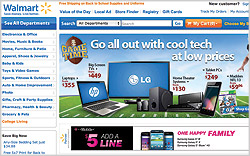 A fine-tuned on-site search engine can drive up conversions and page views. Wal-Mart Stores said its Wal-Mart Labs research and technology hub built a new search engine for
Walmart.com from the ground up. The engine relies on semantic search technology to anticipate the intent of a shopper's search, similar to Amazon.com's engine.
A fine-tuned on-site search engine can drive up conversions and page views. Wal-Mart Stores said its Wal-Mart Labs research and technology hub built a new search engine for
Walmart.com from the ground up. The engine relies on semantic search technology to anticipate the intent of a shopper's search, similar to Amazon.com's engine.
Through the project called
Polaris, Walmart reported experiencing an increase of 20% for online product views, and between 10% and 15% increase in shoppers completing a purchase after searching for a product using the new
search engine.
The technology was developed in 10 months with a little more than a dozen engineers, which makes me -- and I'm sure, others -- wonder why Facebook has not improved on its on-site
search features. The engine groups related terms and phrases, rather than keywords that searchers use to describe products.
advertisement
advertisement
It's not clear whether Walmart developed its own patents just for
the project, but the U.S. Patent and Trademark Office recently granted Walmart a search-related patent titled "Including hyperlinks in a document."
The patent describes "Techniques for
including a hyperlink in a document is disclosed. A document is received via a communications interface. An entity pair is determined by a processor. The entity pair includes a concept included in a
concept taxonomy and a textual representation included in the document. As output, a hyperlink is provided."
Ecommerce sites need a good search engine. If Facebook wants to move down the marketing funnel and compete as an ecommerce
destination, it will need to improve on-site search.
While Polaris should help Walmart better compete online with Amazon.com, it takes more than a better on-site search engine. It requires
integration of online and physical services, which as of last December the company didn't offer.
Sales associates in the store couldn't honor the less expensive online prices. The two
point-of-sale systems kept separate inventory and pricing. By now, I'm pretty sure marketers understand the importance of cross-channel continuity.